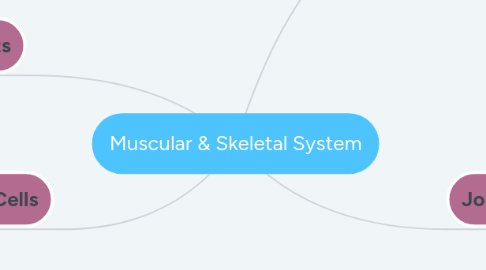
1. Ligaments
1.1. WHAT ARE LIGAMENTS?
1.1.1. Bundles of fibrous connective tissues that connect bones to other bones
1.2. FUNCTION?
1.2.1. To keep our bones in place and prevent us from moving the bones too far in any direction
2. Types of Muscle Cells
2.1. Skeletal muscle cells
2.1.1. Striated, multi-nucleated, voluntary
2.1.1.1. Attached to bones, move our skeleton
2.2. Cardiac muscle cells
2.2.1. Striated, single-nucleus, voluntary
2.2.1.1. Found in heart walls, regulated by pacemaker which controls heart muscles
2.3. Smooth muscle cells
2.3.1. Non-striated, single-nucleus, involuntary
2.3.1.1. Found in hollow organs: intestine, bladder, lungs, and blood vessels
3. Function of Skeletal System
3.1. Body support
3.2. Facilitation of movement
3.3. Protection of internal organs
3.4. Storage of mineral and fats
3.5. Blood cells formation
4. Joints
4.1. Fixed joints
4.1.1. Not moveable
4.1.1.1. The cranium/ the skull
4.2. Moveable joints
4.2.1. Synovial joints: most common moveable joints
4.2.1.1. Pivot joint
4.2.1.1.1. Rotational movement
4.2.1.2. Hinge joint
4.2.1.2.1. Moves along one axis only/ Swinging back and forth
4.2.1.3. Ball and socket joint/ multiaxial joint
4.2.1.3.1. Full rotation
4.2.1.4. Saddle joint/ biaxial joint
4.2.1.4.1. Two-way movement. Up and down and side to side
4.2.1.5. Gliding/ plane joint
4.2.1.5.1. Slight movement in all directions
4.2.2. Non-synovial joints
